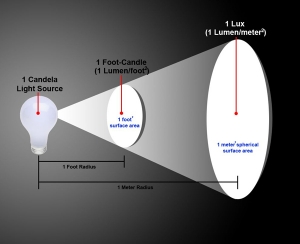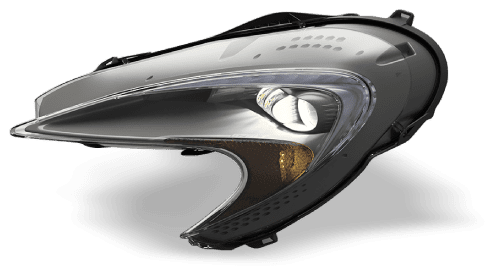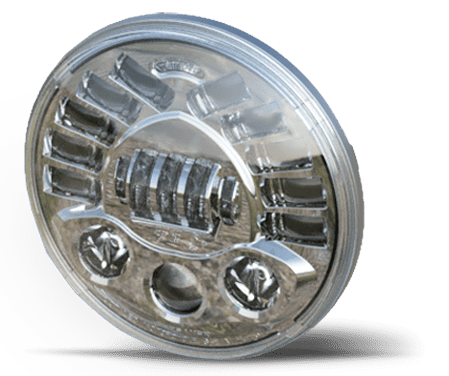
Five Lighting Terms You Should Know

Thanks to advancements in light technology, we enjoy some of the brightest, longest-lasting, and most efficient lighting options that world has ever seen. These light technology advances have also led to an abundance of terminology. To help you stay informed and educated, here are some basic lighting terms for understanding light technology.
Quick Reference of Light Terms
-
Watt: a measure of the total power output of a light source
-
Lumen: a measure of the totalvisible light output of a light source
-
Candlepower: an obsolete term that has been replaced by "candela"
-
Candela: a measure of the intensity of a light source in a particular direction
-
Foot-candles and lux: the amount of visible light falling on a surface
Watts & Lumens
It is a common misconception that higher wattage equals higher light output—in part because incandescent light output generally increases with wattage numbers. With LED technology, this is not the case. LEDs can emit the same, if not more light than a bulb, while consuming less power.
Watts are a measure of power consumption, while lumens are a measurement of visible light output. When you want to know how bright a light will be, you need to identify the lumen output, not the wattage—especially when comparing LED and bulb-based lights.
Types of Lumens
J.W. Speaker offers two types of lumens in our specification sheets:
Raw Lumens
a measure of the theoretical output of a light. In the case of LED lights, this figure is computed by multiplying the manufacturer’s lumen rating for the LED by the number of LEDs in the light.
Raw Lumens are NOT representative of the actual light output because it does not take into account the electrical and optical losses that impact all lights.
Effective Lumens
a measure of the total power output of a light source. The Effective Lumen output is measured using a photometric testing device and takes into consideration electrical and optical losses, so it is a better representation of the useful visible light that is produced.
Read more on how to calculate Effective Lumens here.
Candlepower & Candela
Candela are similar to lumens in that both deal with light output as perceived by the human eye. The key difference between the two is that candela is specifically a measurement of directional intensity. One candela is close to the light intensity produced by an ordinary candle as perceived by the human eye, and addresses how bright a light source is in a particular direction.
Although the term “candlepower” was once the predominant unit of measure used to describe the intensity of a light, this term is now considered to be obsolete. The current standard unit of measure to be used is “candela.”
Foot-Candles & Lux
Foot-candles and lux measure the same thing—the amount of visible light that falls on a surface.
The difference is that the foot-candle uses the Imperial standard measuring system (feet, pounds, etc.), while the lux uses the metric system (meters, grams, etc.).
A single foot-candle is equivalent to the amount of light that falls on a surface that is one foot away from a single candle, and a lux is the amount of light that falls on a surface one meter away from a candle. For conversion, 1 foot-candle = 10.764 lux.
About J.W. Speaker
J.W. Speaker is focused on developing innovative, high-performance vehicular lighting solutions for OEM and aftermarket customers around the world. Specialized in LED and other emerging lighting technologies, J.W. Speaker is proud to design, manufacture and assemble products in Germantown, Wisc. For more information, contact J.W. Speaker at (800) 558-7288 or news@jwspeaker.com.
Quick Reference
- Watt: a measure of the total power output of a light source
- Lumen: a measure of the total visible light output of a light source
- Candlepower: an obsolete term that has been replaced by “candela”
- Candela: a measure of the intensity of a light source in a particular direction
- Foot-candles and lux: the amount of visible light falling on a surface
Watts & Lumens
It is a common misconception that higher wattage equals higher light output—in part due to the fact that incandescent light output generally increases with wattage numbers. With LED technology, this is not the case. LEDs can emit the same, if not more light than a bulb, while consuming less power. Watts are a measure of power consumption, while lumens are a measurement of visible light output. When you want to know how bright a light will be, you need to identify the lumen output, not the wattage—especially when comparing LED and bulb-based lights.Types of Lumens
J.W. Speaker offers two types of lumens in our specification sheets:- Raw Lumens: a measure of the theoretical output of a light. In the case of LED lights, this figure is computed by multiplying the manufacturer’s lumen rating for the LED by the number of LEDs in the light.Raw Lumens are NOT representative of the actual light output because it does not take into account the electrical and optical losses that impact all lights.
- Effective Lumens: a measure of the total power output of a light source. The Effective Lumen output is measured using a photometric testing device and takes into consideration electrical and optical losses, so it is a better representation of the useful visible light that is produced.Read more on how to calculate Effective Lumens here.
Candlepower & Candela
Candela are similar to lumens in that both deal with light output as perceived by the human eye. The key difference between the two is that candela is specifically a measurement of directional intensity. One candela is close to the light intensity produced by an ordinary candle as perceived by the human eye, and addresses how bright a light source is in a particular direction. Although the term “candlepower” was once the predominant unit of measure used to describe the intensity of a light, this term is now considered to be obsolete. The current standard unit of measure to be used is “candela.”Foot-Candles & Lux
 Foot-candles and lux measure the same thing—the amount of visible light that falls on a surface.
The difference is that the foot-candle uses the Imperial standard measuring system (feet, pounds, etc.), while the lux uses the metric system (meters, grams, etc.).
A single foot-candle is equivalent to the amount of light that falls on a surface that is one foot away from a single candle, and a lux is the amount of light that falls on a surface one meter away from a candle. For conversion, 1 foot-candle = 10.764 lux.
Foot-candles and lux measure the same thing—the amount of visible light that falls on a surface.
The difference is that the foot-candle uses the Imperial standard measuring system (feet, pounds, etc.), while the lux uses the metric system (meters, grams, etc.).
A single foot-candle is equivalent to the amount of light that falls on a surface that is one foot away from a single candle, and a lux is the amount of light that falls on a surface one meter away from a candle. For conversion, 1 foot-candle = 10.764 lux. 

